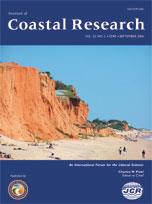High-frequency measurements of airflow from ultrasonic anemometers and time-averaged cup anemometer profiles were taken during an oblique alongshore sand-transporting event (6.7 m/s) over a vegetated foredune in May 2002 as part of a larger study on the sedimentary dynamics of a beach-dune complex in Greenwich Dunes, Prince Edward Island National Park, Canada. Local flow and sand transport pathways deviated significantly from the regional wind because of topographic steering of oblique alongshore airflow on the beach back toward the foredune in the backshore. Flow decelerated on the lower seaward slope of the foredune because of flow stagnation and vegetation-induced roughness effects. On the upper seaward slope, flow veered crest-parallel because of secondary flow effects, including potential flow reversal, acceleration, and interaction with faster regional flow. An inflection point in velocity profiles indicates a momentum sink at plant canopy height, and above this height exists a distinct shear layer. Flow acceleration occurs only on the upper slope above the plant canopy as the shear layer intensifies. Flow steadiness, as indicated by the coefficient of variation in horizontal (U) and vertical (W) velocity, also declines up the seaward slope, in contrast to measurements of flow over unvegetated dunes, perhaps because of increasing vegetation-induced drag and turbulence. Gusting and vertical bursting was evident as honami motion in the beachgrass and was responsible for maintaining intermittent saltation into the foredune. Temporal correlations exist between U, W, and flow angle. As flow shifted onshore, both U and W increased because of enhanced topographic forcing and increased vertical lift on the lower seaward slope, whereas when flow shifted alongshore, U and W declined because of reduced forcing and acceleration effects because the dune is effectively less steep to flow.
Although these dunes align well with the vector of the regional resultant sediment drift potential, sand transport pathways followed local flow vectors of varying magnitude and direction. Offshore to oblique alongshore winds are typical of the summer wind regime, and, although frequently incompetent, they contribute to dune maintenance by cycling sand to the backshore for incipient foredune growth, scarp infilling, or both. To date, the role of secondary flows under alongshore winds in foredune morphodynamics has not been well documented.





